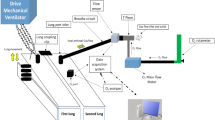Abstract
Oxygen gas flowmeters (OGF) are used to regulate the oxygen flow in acute and chronic care. In hospitals, Thorpe tubes (TT) are the classical systems most used for delivering oxygen. In recent years, the oxygen flow restrictor (OFR) has appeared. These devices use a series of calibrated openings in a disk that can be adjusted to deliver different flow rates. These devices have a reputation for delivering more accurate oxygen flow rates compared to classical OGFs. However, to our knowledge, few study has examined this supposition. This study aimed to compare and evaluate the accuracy and precision of the ready-to-use TTs and OFRs. OGFs were selected from hospitals in Belgium and France. Before performing the flow measurements, the inlet pressure was checked. The accuracy of the OGF was analyzed with a calibrated thermal mass flowmeter (RED Y COMPACT™ GCM—0 to 20 L/min—VÖGTLIN Instruments). Different flows (2, 4, 6, 9 or 12 L/min) were evaluated. Linear regression analysis, bias (with confidence interval) and lower and upper limit of the agreement were calculated for TTs and OFRs. All measurements are expressed in absolute values. Four-hundred-seventy-six TTs and 96 OFRs were analyzed. The intra-class correlation coefficient calculated for the calibrated thermal mass flowmeter was > 0.99 and reflected the excellent reliability of our measurements. For TTs, the bias value was − 0.24 L/min (± 0.88), and the limits of agreement were − 1.97 to 1.48 L/min. For OFRs, the bias value was − 0.30 L/min (± 0.54), and the limits of agreement were − 1.36 to 0.77 L/min. As the flow increased, the accuracy of all analyzed OGFs decreased. With the increasing flow, some data fell outside the limits of agreement, and the trend increased with the elevated oxygen flow. TTs were less accurate compared to OFRs due to the increased flow variability. However, for TTs and OFRs, as the required flow is elevated, the dispersion of values increases on both sides of the actual flow.


Similar content being viewed by others
References
Pavlov N, Haynes AG, Stucki A, Jüni P, Ott SR. Long-term oxygen therapy in COPD patients: population-based cohort study on mortality. Int J Chron Obstruct Pulmon Dis. 2018;13:979–88.
Cairo J, Pilbeam S. Mosby’s respiratory care equipment. Amsteram: Elsevier; 2018.
Duprez F. Accuracy of medical oxygen flow meters: a multicentric field study. Health. 6(15):1978–83; 2014
Duprez F, Michotte JB, Cuvelier G, Legrand A, Mashayekhi S, Reychler G. Accuracy of oxygen flow delivered by compressed-gas cylinders in hospital and prehospital emergency care. Respir Care. 2018;63(3):332–8.
Davidson J, Gazzeta C, Torres LC, Jardim JR, Nascimento OA. Precision and accuracy of oxygen flow meters used at hospital settings. Respir Care. 2012;57(7):1071–5.
Stub D, Smith K, Bernard S, Bray JE, Stephenson M, Cameron P, et al. A randomized controlled trial of oxygen therapy in acute myocardial infarction air verses oxygen in myocardial infarction study (AVOID study). Am Heart J. 2012;163(3):339.e1–45.e1.
Hafner S, Beloncle F, Koch A, Radermacher P, Asfar P. Hyperoxia in intensive care, emergency, and peri-operative medicine: Dr. Jekyll or Mr. Hyde? A 2015 update. Ann Intensive Care. 2015;5(1):42.
Bland JM, Altman DG. Statistical methods for assessing agreement between two methods of clinical measurement. Lancet Lond Engl. 1986;1(8476):307–10.
Bland JM, Altman DG. Measuring agreement in method comparison studies. Stat Methods Med Res. 1999;8(2):135–60.
Koo TK, Li MY. A guideline of selecting and reporting intraclass correlation coefficients for reliability research. J Chiropr Med. 2016;15(2):155–63.
Lamb K, Piper D. Southmedic OxyMaskTM compared with the Hudson RCI® non-rebreather MaskTM: safety and performance comparison. Can J Respir Ther CJRT, Rev Can Thér Respir RCTR. 2016;52(1):13–5.
Benaron DA, Benitz WE. Maximizing the stability of oxygen delivered via nasal cannula. Arch Pediatr Adolesc Med. 1994;148(3):294–300.
Frat J-P, Thille AW, Mercat A, Girault C, Ragot S, Perbet S, et al. High-flow oxygen through nasal cannula in acute hypoxemic respiratory failure. N Engl J Med. 2015;372(23):2185–96.
Duprez F, Mashayekhi S, Cuvelier G, Legrand A, Reychler G. A New formula for predicting the fraction of delivered oxygen during low-flow oxygen therapy. Respir Care. 2018;63(12):1528–34.
Walsh M, Engle W, Laptook A, Kazzi SNJ, Buchter S, Rasmussen M, et al. Oxygen delivery through nasal cannulae to preterm infants: can practice be improved? Pediatrics. 2005;116(4):857–61.
Finer NN, Bates R, Tomat P. Low flow oxygen delivery via nasal cannula to neonates. Pediatr Pulmonol. 1996;21(1):48–51.
Susanto C, Thomas PS. Assessing the use of initial oxygen therapy in chronic obstructive pulmonary disease patients: a retrospective audit of pre-hospital and hospital emergency management. Intern Med J. 2015;45(5):510–6.
Jubran A. Pulse oximetry. Crit Care Lond Engl. 2015;19:272.
O’Driscoll BR, Howard LS, Bucknall C, Welham SA, Davison AG, British Thoracic Society. British Thoracic Society emergency oxygen audits. Thorax. 66(8):734–5; 2011
Author information
Authors and Affiliations
Corresponding author
Ethics declarations
Conflict of interest
The authors declare that they have no conflict of interest.
Ethical Approval
This article is a bench study, there are no human people involved.
Additional information
Publisher's Note
Springer Nature remains neutral with regard to jurisdictional claims in published maps and institutional affiliations.
Rights and permissions
About this article
Cite this article
Duprez, F., Dubois, A., Ollieuz, S. et al. Thorpe tube and oxygen flow restrictor: what’s flow accuracy?. J Clin Monit Comput 35, 337–341 (2021). https://doi.org/10.1007/s10877-020-00476-0
Received:
Accepted:
Published:
Issue Date:
DOI: https://doi.org/10.1007/s10877-020-00476-0




